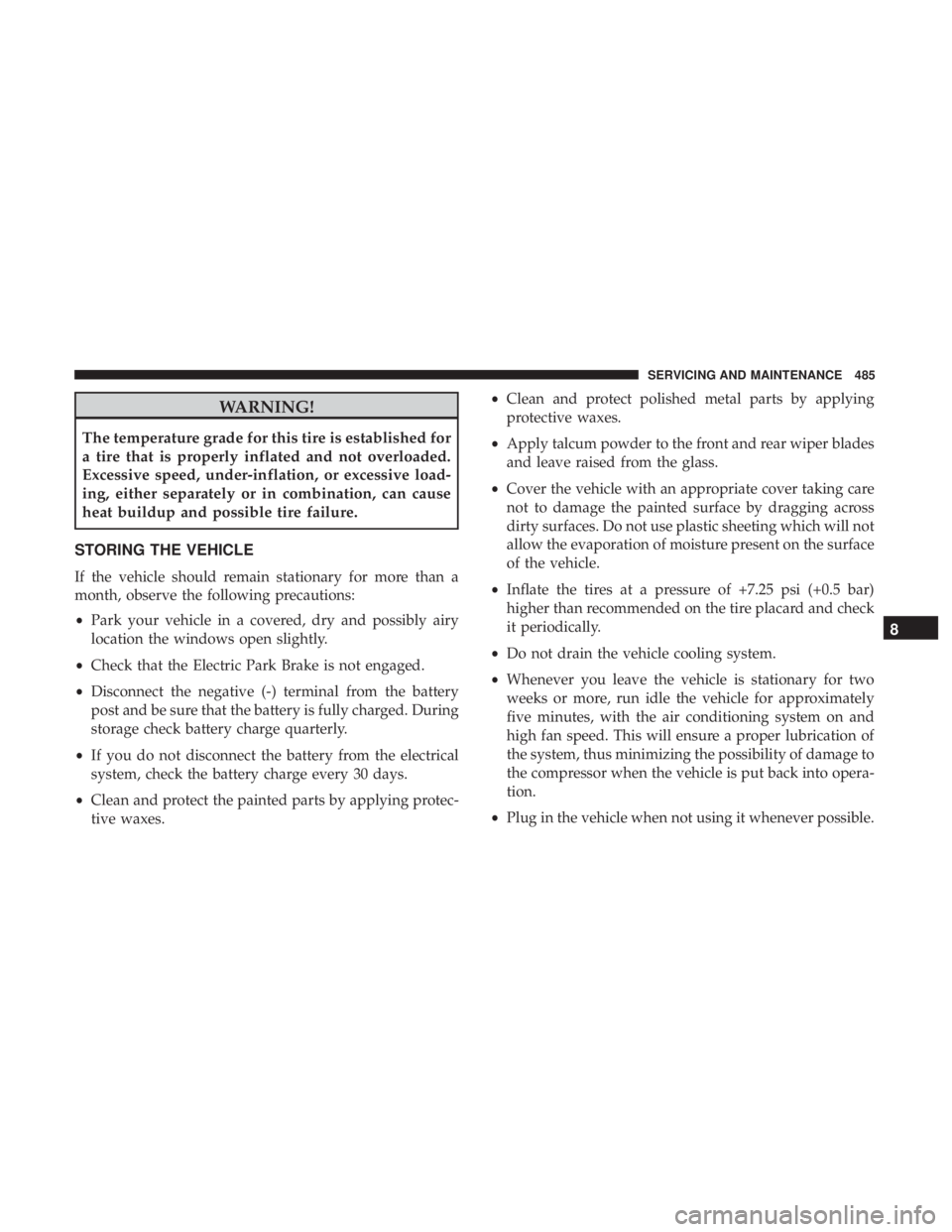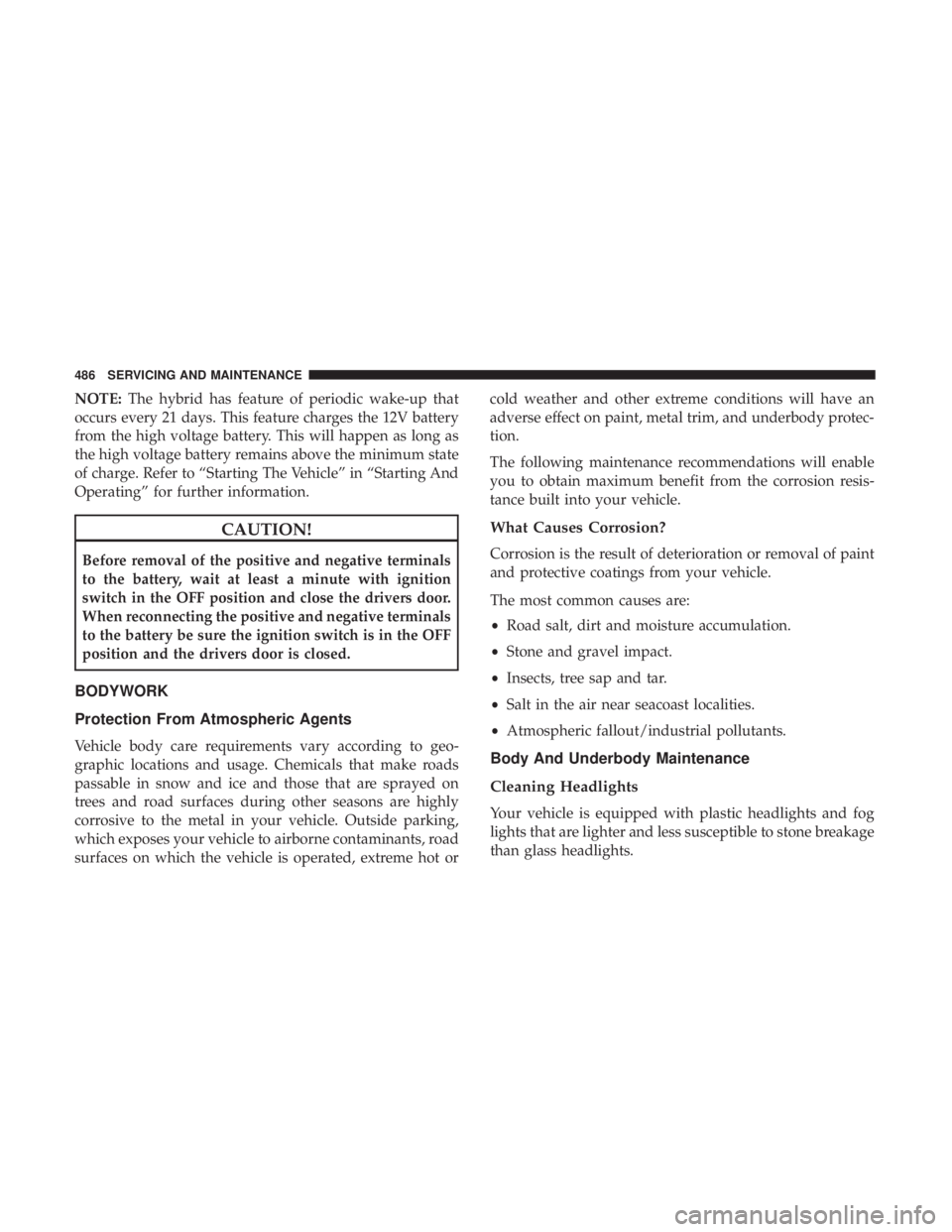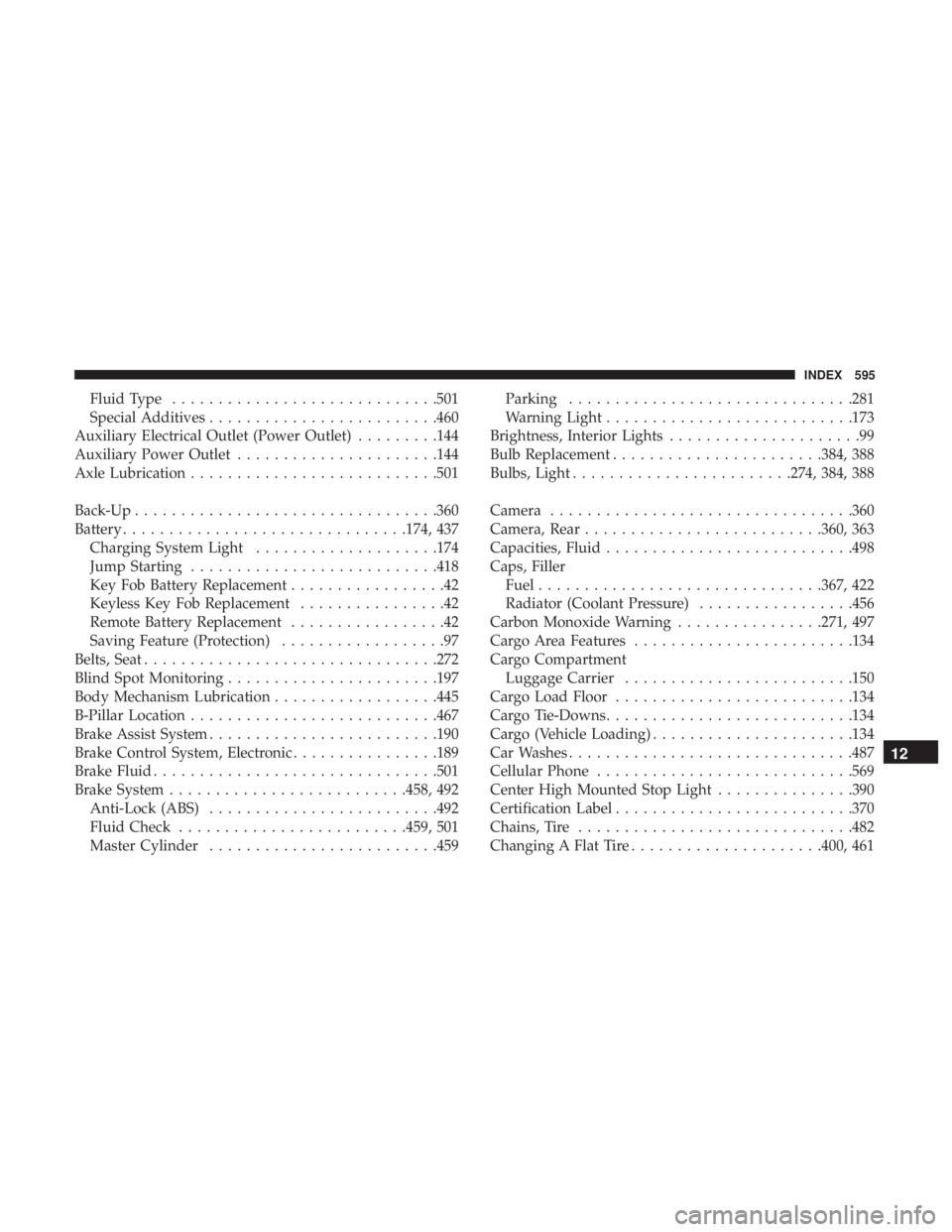2018 CHRYSLER PACIFICA HYBRID battery location
[x] Cancel search: battery locationPage 421 of 614

Carefully move the vehicle to a Level 1 or Level 2 charge
location. While the vehicle is being moved, the external
12V power must remained connected to the vehicle
jump posts.
NOTE: Be careful when moving the vehicle - ensure that
control of the vehicle is maintained. Also, ensure that
vehicle is secured to prevent unintentional movement
during and after moving the vehicle. If the external 12V
power becomes disconnected from the vehicle jump posts
or there is an interruption of the 12V power while moving
the vehicle, the vehicle’s transmission may engage PARK.
When the vehicle is at the charging location, shift the
transmission back to PARK, apply the electric park brake,
and start the high voltage battery charging. Once the
vehicle has been secured against unintentional movement
and high voltage battery charging has been initiated, the
jumper cables can be removed from the vehicle jump posts. Jump starting can be dangerous if done improperly so
please follow the procedures in this section carefully.
NOTE:
When using a portable battery booster pack, follow
the manufacturer ’s operating instructions and precautions.
WARNING!
Do not attempt jump starting if the battery is frozen. It
could rupture or explode and cause personal injury.
CAUTION!
Do not use a portable battery booster pack or any other
booster source with a system voltage greater than 12
Volts or damage to the battery, alternator or electrical
system may occur.
7
IN CASE OF EMERGENCY 419
Page 422 of 614

Preparations For Jump Start
The remote battery posts in your vehicle is located on the
left side of the engine compartment.
WARNING!
You can be seriously injured or killed working on or
around a motor vehicle:
•Keep hands away from the radiator cooling fan when
the hood is raised. The fan starts automatically and
may start at any time, whether the engine is running
or not.
• Remove any jewelry such as rings, watches and
bracelets that could make an inadvertent electrical
contact.
• Keep open flames or sparks away from the battery.
Batteries contain sulfuric acid that can burn your
skin or eyes and generate hydrogen gas which is
flammable and explosive.
1. Apply the parking brake and place the ignition to OFF.
NOTE: If the 12V Battery has been sufficiently discharged,
this may not be possible.
2. Turn off the heater, radio, and all unnecessary electrical accessories.
Jump Starting Locations
(+) — Positive Battery Post
(-) — Negative Battery Post 420 IN CASE OF EMERGENCY
Page 428 of 614

NOTE:
•You must ensure that the Auto Park Brake feature is
disabled before towing this vehicle (if rear wheels are on
the ground), to avoid inadvertent Electric Park Brake
engagement. The Auto Park Brake feature is enabled or
disabled via the customer programmable features in the
Uconnect Settings.
• Vehicles with a discharged battery or total electrical
failure when the Electric Parking Brake (EPB) is en-
gaged, will need a wheel dolly or jack to raise the rear
wheels off the ground when moving the vehicle onto a
flatbed.
The manufacturer recommends towing your vehicle with
all four wheels OFFthe ground using a flatbed.
If flatbed equipment is not available, this vehicle must be
towed with the front wheels OFF the ground (using a
towing dolly, or wheel lift equipment with the front wheels
raised).
NOTE: Ensure that the Electric Park Brake is released, and
remains released, while being towed.CAUTION!
Towing this vehicle in violation of the above require-
ments can cause severe transmission damage. Damage
from improper towing is not covered under the New
Vehicle Limited Warranty.
Vehicle Recovery Tow Points
Your vehicle is equipped with Vehicle Recovery Points that
can be used to recover a disabled vehicle, located on the
underbody of the vehicle.
NOTE:
• Ensure that the towing service tow hooks are properly
seated and secured in the attachment points.
• This recovery tow feature should be used by a trained
professional only.
• Use approved receptacle location to free the disabled
vehicle from its environment.
426 IN CASE OF EMERGENCY
Page 487 of 614

WARNING!
The temperature grade for this tire is established for
a tire that is properly inflated and not overloaded.
Excessive speed, under-inflation, or excessive load-
ing, either separately or in combination, can cause
heat buildup and possible tire failure.
STORING THE VEHICLE
If the vehicle should remain stationary for more than a
month, observe the following precautions:
• Park your vehicle in a covered, dry and possibly airy
location the windows open slightly.
• Check that the Electric Park Brake is not engaged.
• Disconnect the negative (-) terminal from the battery
post and be sure that the battery is fully charged. During
storage check battery charge quarterly.
• If you do not disconnect the battery from the electrical
system, check the battery charge every 30 days.
• Clean and protect the painted parts by applying protec-
tive waxes. •
Clean and protect polished metal parts by applying
protective waxes.
• Apply talcum powder to the front and rear wiper blades
and leave raised from the glass.
• Cover the vehicle with an appropriate cover taking care
not to damage the painted surface by dragging across
dirty surfaces. Do not use plastic sheeting which will not
allow the evaporation of moisture present on the surface
of the vehicle.
• Inflate the tires at a pressure of +7.25 psi (+0.5 bar)
higher than recommended on the tire placard and check
it periodically.
• Do not drain the vehicle cooling system.
• Whenever you leave the vehicle is stationary for two
weeks or more, run idle the vehicle for approximately
five minutes, with the air conditioning system on and
high fan speed. This will ensure a proper lubrication of
the system, thus minimizing the possibility of damage to
the compressor when the vehicle is put back into opera-
tion.
• Plug in the vehicle when not using it whenever possible.
8
SERVICING AND MAINTENANCE 485
Page 488 of 614

NOTE:The hybrid has feature of periodic wake-up that
occurs every 21 days. This feature charges the 12V battery
from the high voltage battery. This will happen as long as
the high voltage battery remains above the minimum state
of charge. Refer to “Starting The Vehicle” in “Starting And
Operating” for further information.
CAUTION!
Before removal of the positive and negative terminals
to the battery, wait at least a minute with ignition
switch in the OFF position and close the drivers door.
When reconnecting the positive and negative terminals
to the battery be sure the ignition switch is in the OFF
position and the drivers door is closed.
BODYWORK
Protection From Atmospheric Agents
Vehicle body care requirements vary according to geo-
graphic locations and usage. Chemicals that make roads
passable in snow and ice and those that are sprayed on
trees and road surfaces during other seasons are highly
corrosive to the metal in your vehicle. Outside parking,
which exposes your vehicle to airborne contaminants, road
surfaces on which the vehicle is operated, extreme hot or cold weather and other extreme conditions will have an
adverse effect on paint, metal trim, and underbody protec-
tion.
The following maintenance recommendations will enable
you to obtain maximum benefit from the corrosion resis-
tance built into your vehicle.
What Causes Corrosion?
Corrosion is the result of deterioration or removal of paint
and protective coatings from your vehicle.
The most common causes are:
•
Road salt, dirt and moisture accumulation.
• Stone and gravel impact.
• Insects, tree sap and tar.
• Salt in the air near seacoast localities.
• Atmospheric fallout/industrial pollutants.
Body And Underbody Maintenance
Cleaning Headlights
Your vehicle is equipped with plastic headlights and fog
lights that are lighter and less susceptible to stone breakage
than glass headlights.
486 SERVICING AND MAINTENANCE
Page 597 of 614

Fluid Type............................ .501
Special Additives ........................ .460
Auxiliary Electrical Outlet (Power Outlet) .........144
Auxiliary Power Outlet ..................... .144
Axle Lubrication .......................... .501
Back-Up ................................ .360
Battery .............................. .174, 437
Charging System Light ....................174
Jump Starting .......................... .418
Key Fob Battery Replacement .................42
Keyless Key Fob Replacement ................42
Remote Battery Replacement .................42
Saving Feature (Protection) ..................97
Belts, Seat ............................... .272
Blind Spot Monitoring ...................... .197
Body Mechanism Lubrication ..................445
B-Pillar Location .......................... .467
Brake Assist System ........................ .190
Brake Control System, Electronic ................189
Brake Fluid .............................. .501
Brake System ......................... .458, 492
Anti-Lock (ABS) ........................ .492
Fluid Check ........................ .459, 501
Master Cylinder ........................ .459Parking
.............................. .281
Warning Light .......................... .173
Brightness, Interior Lights .....................99
Bulb Replacement ...................... .384, 388
Bulbs, Light ....................... .274, 384, 388
Camera ................................ .360
Camera, Rear ......................... .360, 363
Capacities, Fluid .......................... .498
Caps, Filler Fuel .............................. .367, 422
Radiator (Coolant Pressure) .................456
Carbon Monoxide Warning ................271, 497
Cargo Area Features ....................... .134
Car
go Compartment
Luggage Carrier ........................ .150
Cargo Load Floor ......................... .134
Cargo Tie-Downs .......................... .134
Cargo (Vehicle Loading) ..................... .134
Car Washes .............................. .487
Cellular Phone ........................... .569
Center High Mounted Stop Light ...............390
Certification Label ......................... .370
Chains, Tire ............................. .482
Changing A Flat Tire .....................400, 461
12
INDEX 595